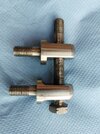Castings or forgings can be challenging while machining them. You need some good planning for setting them up in a jig for getting bores right in the best place. I have found on Brampton forgings/castings some places with very low wall thicknesses. So before sending them to Robbins I did some TIG welding for beefing up these parts with nickel-chrome buffer rods. You will be prepared for some days of rectifying warped components from welding and all sorts of poor alignments.
So for commenting the defect I´d think there is very low wall thickness that showed up after grease pressed in.
I will be interested in reading here how the bearing recesses will be rectified after welding for restoring alignments of bearings. Or otherwise have undersize bushes fitted and line-reamed then for correct fits ??
These days I have finished a girder repair of the 1935 Guzzi which got new IGUS "plastic" bushes , replacing SKF Permaglide graphite/teflon bushes. Those had 30 000 km use , with no wear on stainless spindles, no lube certainly all the time. Spindles are kept for the new bushes of course. Great thing is, you can line-ream the IGUS material, cheap to get as well. The Permaglide are coated bushes, so no reaming is possible with these.
Vic
So for commenting the defect I´d think there is very low wall thickness that showed up after grease pressed in.
I will be interested in reading here how the bearing recesses will be rectified after welding for restoring alignments of bearings. Or otherwise have undersize bushes fitted and line-reamed then for correct fits ??
These days I have finished a girder repair of the 1935 Guzzi which got new IGUS "plastic" bushes , replacing SKF Permaglide graphite/teflon bushes. Those had 30 000 km use , with no wear on stainless spindles, no lube certainly all the time. Spindles are kept for the new bushes of course. Great thing is, you can line-ream the IGUS material, cheap to get as well. The Permaglide are coated bushes, so no reaming is possible with these.
Vic

